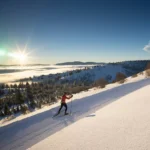Introduction
At the end of every cross-country season, CCSAA and Snow Sports Insights survey a group of cross country skiers to learn more about them, their experiences on-trail this season, their plans for the off-season, and what keeps them coming back to the trails. They told us more about who they are, what they like and what they would improve on their home trails, what they do when there is no snow on the trail, and which issues they think are important. The Cross Country End of Season survey results provide a view of the season from the customer’s perspective.
Participation
Cross country skiers do not sit idle when their skis are put away for the season. Nearly every cross-country skier finds their way to the trail in the off-season for hiking, birding, and other wildlife viewing. Half of cross-country skiers will be back to the trails on mountain bikes, nearly 70% will ride road bikes, and about the same number will participate in paddle sports. In fact, cross-country skiers are some of the most active participants across all categories in outdoor recreation.

Who They Are
Cross country skiers are active, and one might think that many of them see themselves as super-athletes, type-A achievers, uber competitors but nothing could be further from their self-perceptions. Cross country skiers see themselves as casual, low-key intellectuals who just love the outdoors. They care more about their bucolic trail experiences than in adrenaline-fueled thrills or even getting a workout. They are animal lovers and pragmatists who have no interest in formality.

Brand Attributes
We asked respondents to think about the brands they like best and rate aspects of those brands in terms of the attributes they find most attractive. Cross country skiers rated quality, performance, and value highest, well above attributes like style, authenticity, fun. In fact, quality was the top-rated attribute by 15% ahead of performance. The rating of attributes indicates that cross-country skiers are pragmatic consumers who want products to work well. Although style and fun are way down the list of attributes this audience values most, it’s not the last attribute they consider. Note that nearly one-third indicated that sustainability was in the top three attributes they consider, and more than 1 in 5 listed social responsibility in the top three. This bent toward sustainability and social responsibility may be correlated with higher levels of educational attainment apparent in the cross country skier participant base and the positive relationship between pro-environmental attitudes and educational attainment.

Concern About Climate Change
Regardless of the correlates, cross country skiers are concerned about the environment. In fact, it’s easier to look at the small percentage who indicated that they aren’t concerned about the impacts of climate change on cross country skiing; just 6% said they don’t care at all.

Go To Ski Area
We asked respondents to name their go-to trails and comment on what they would choose to improve about those trails if they could. We have enough response to provide customized feedback to more than 100 trail areas, a project that will allow the CCSAA to provide direct value to trail areas that are members by delivering feedback with the option to follow-up with respondents who commented about their trails.

It was no surprise that trail development was the area respondents wanted to invest in most often. They also chose grooming equipment, and snowmaking in the top three. Interestingly, other amenities ski areas can provide including food/beverage, retail, and gear rental made a showing further down on the list. There were enough open-ended comments to analyze separately for responses left in the “other (please describe)” response category. About 1 in 5 respondents (out of 534) left a comment in the “other” category. In a delightful note, a third of the respondents who left comments here did so to express love for their home trail areas. Others wanted to talk about specifics about grooming, facilities (bathrooms), and signage.

Conclusion
Overall, cross country skiers are casual outdoorsy intellectuals who care a lot about their trails all year long. When they think about their cross country ski experiences, they continue in their pragmatic vein, thinking about grooming and trail development first when valuing their home trails and considering quality and performance over style in their apparel and gear choices. We can find them on the trail, or simply somewhere outdoors recreating all year long. If you’re a member of the CCSAA, you can get direct access to these respondents for follow-up questions via survey or by discussion group. Contact CCSAA for more information.
A few more facts about the respondents
The average age of our respondents was 55.6 years. There was adequate response in all age groups between 25 and 75 years.
Our respondent group included 56% female, 41% males, and 2% non-binary persons.
.


Respondents indicated how frequently they participated in cross country skiing last season. We parsed the data to determine whether the responses had any significant variance by age, by gender, or by frequency of participation. There were some material differences by gender (women leaned more environmental) but overall, there weren’t significant differences in responses by age or by frequency of participation.

Methodology and Limitations:
SnowSports Insights sent a link to the online survey to 2100 cross country skiers and received 534 responses in June and July 2022. The margin of error (considering a participant base of 4.2M skiers) is +/- 4.24% at a 95% confidence interval. If this survey were to be conducted 100 times with an analogous sample, 95 of them would come back with responses within 4% of the results reported here.
Every sample presents some bias in the response. In this sample, there were more women represented in the respondent base (56%) than in the overall cross country participant base (40%). Survey respondents often have stronger opinions, both positive and negative about the survey subject than non-respondents.


